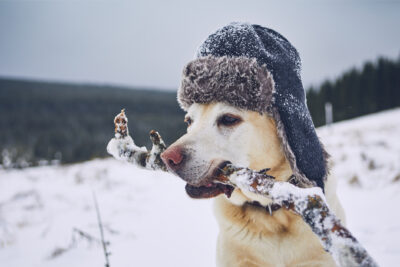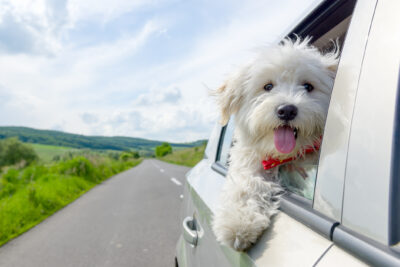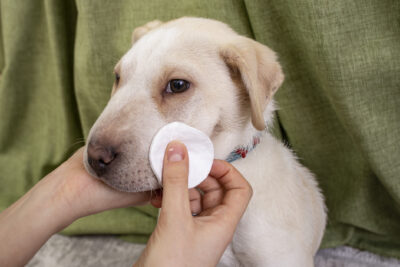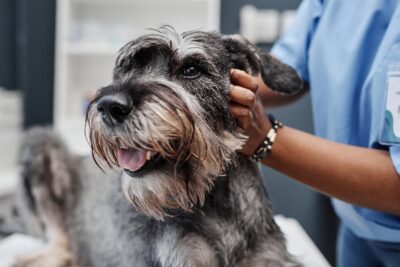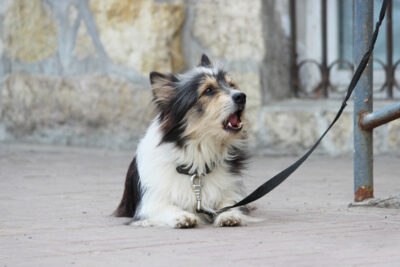Dog Dewclaw Injuries: Everything You Need to Know

Overview
- The dewclaw is the small toe on the inside of a dog’s front or back leg.
- Common injuries include torn or broken, overgrown, ingrown or infected dewclaws.
- If a dog has dewclaws, they must be commonly checked especially for overgrowth.
- The best way to prevent dog dewclaw injuries is to trim the nail regularly.
All featured products are chosen at the discretion of the GreatPetCare editorial team and do not reflect a direct endorsement by the author or reviewer.
How many toes does your dog have? It may surprise you to learn that the answer varies from dog to dog. It could be as few as 16 or as many as 24! This is all because of a little-known appendage called the dewclaw (or dew claw).
Most dogs have five toes on their front paws (four weight-bearing toes and a little toe—the dewclaw). On their rear paws, most dogs sport four toes. Some dogs, however, may also have a small dewclaw on their back paws (or even two dew claws)!
As luck would have it, these small toes turn out to be the ones that cause dogs (and dog parents) the most trouble. To help you deal with them safely, here’s what you need to know about dew claws on dogs.
What is a Dewclaw on a Dog?

The dewclaw is the small, non-weight-bearing toe on the inside of a dog’s front or back leg. Almost all dogs have dewclaws on their front paws, but some will also have dewclaws on their hind limbs.
Certain breeds, such as the Great Pyrenees and Anatolian Shepherds, will have a double dewclaw, meaning that they have two extra toes on the back feet. The Norwegian Lundehund, a rare dog breed, boasts at least six toes on each foot! (1)
The front dewclaw is typically a fully formed toe, meaning that it has bones and is firmly attached to the limb. More often than not, rear dewclaws are only attached by skin or a small tendon. They tend to be much more mobile and may even flop around. However, on occasion, they can also have a bony attachment.
Contrary to popular belief, front dewclaws are not simply extra appendages. Front dewclaws are actually useful to dogs who have them. In fact, dogs regularly use them to grasp and stabilize toys or treats while chewing.
Dogs also use their front dewclaw to provide extra traction. This comes in handy for things like digging, hoisting themselves up onto the couch, or even over fences.
Research even suggests that the dewclaws contact the ground when dogs are running at high speeds (2). When this happens, the dewclaw digs into the ground, preventing the rest of the limb from twisting.
Common Dog Dewclaw Injuries

Unfortunately, dewclaws get injured more often than other dog nails. Signs of a dewclaw injury may include:
- limping
- bleeding
- excessive licking
- swelling or warmth around the toe
- yelping or flinching when you touch the affected limb
If you notice any of these signs in your dog, you should visit your veterinarian to get to the root of the issue.
Keep in mind that some dogs are very stoic and may mask signs of pain. Even if your dog isn’t showing it, if you notice they have a dew claw injury, it is likely causing them a lot of pain.
The most common dewclaw issues include:
Torn or broken dewclaws

Dewclaws can easily become snagged during play or work due to their position on the inside of the leg. Therefore, torn or broken dewclaws are common in highly active dogs. Broken dewclaws can be quite bloody for such a small toe, but the amount of blood often depends on how severely the nail is broken.
When a dog’s dewclaw is torn or broken, the “quick” of the nail is often left exposed. The quick of the nail houses the nail’s nerves and blood supply, so it is incredibly painful when injured. An exposed quick is so sensitive that even cold air can feel uncomfortable.
No one wants to see their pup in pain. So the first thing most pet parents want to know is how to treat a broken dew claw at home. However, torn or broken dewclaws require professional medical attention.
As a temporary fix, you can apply a bandage or styptic powder at home to help stop bleeding. But this should not be a substitute for immediate veterinary care.


When your dog tears or breaks a dewclaw, the veterinarian will need to remove any part of the nail that is mobile or only partially attached. This is because any movement of the damaged nail will continue to irritate the exposed quick.
Next, they will clean the area carefully with an antiseptic solution and shave the hair away from the nail to prevent infection. Your vet may also bandage the paw for a few days to help protect the sensitive quick.
To avoid complications, it’s very important to ensure the bandage is not so tight that it limits circulation to the rest of the paw. It is also important to keep your pup from chewing at their injury site, tearing off their bandages, or licking the dewclaw, which can cause infection.
If you don’t want to worry about keeping constant watch over the recovering patient, here are some things that can aid their recovery. If your dog is licking their dew claw or chewing the bandage, an Elizabethan collar (commonly called an e-collar) like the BUSTER Comfort Collar may help. There are also specially designed wound covers, like the KRUUSE Chew-Stop Bandage, that are impregnated with a non-toxic bitter flavor to prevent chewing.


Finally, your veterinarian will likely prescribe your dog pain relief medications and antibiotics.
Thankfully, dog nails grow and heal quickly. After a few days, the quick is usually no longer sensitive, and your pet’s nail will begin to regrow. Within a few weeks, the nail will look relatively normal.
Overgrown dewclaws

Regular dog nails often wear down naturally from contact with floors and pavement. However, because dewclaws seldom encounter abrasive surfaces, they’re more likely to become overgrown. This condition is especially common in more sedentary animals who do not dig or play often.
Overgrown dewclaws endanger your dog because they can easily snag on things, like the carpet or couch, and become torn or broken.
Luckily, dog dew claw removal isn’t typically necessary unless the overgrown dewclaw causes repeated injuries or infections. All you need is a good pair of nail clippers and some practice to get comfortable with regular nail trimming.
The quick of the nail grows as the nail grows. So be very careful when trimming overgrown dewclaws, and only trim small pieces away at a time. With regular trimmings, the quick will eventually recede. (Check out our step-by-step tutorial on How to Use Dog Nail Clippers here for help keeping dog toenails, including dewclaws, in check.)

Ingrown dewclaws

Due to their natural curvature, overgrown dewclaws can pierce the flesh of the toe if left unchecked. These ingrown dew claws are common in long-haired breeds, whose coats often hide the dew nails.
It’s also common in active dogs whose other nails wear down naturally with regular play. Since they may not require frequent nail trimming with a groomer or vet, it’s easy for their dewclaws to get overlooked. As you can imagine, a dewclaw curling into the pet’s flesh is very painful, and a veterinary visit is required.
Your veterinarian will carefully trim the ingrown dewclaw, clean the wound, and may also apply a bandage for a few days. Additionally, your dog will need pain relief medication as well as antibiotics. It’s a good idea to have your dog wear an e-collar for a week or two while the wound is healing. Licking the wound can delay healing and cause infection.
Infected dewclaws

Dog dew claw infections may result from a wide range of causes. Without proper care, an ingrown dew claw can become infected. But any trauma to the nail itself or the skin near the dewclaw could lead to infection. The risk increases when dogs lick or chew at a sore paw, transferring bacteria from their mouth to the nail bed.
Infected dewclaws are usually bacterial infections, but can sometimes be fungal. If you notice any of the following signs, an infected dewclaw could be the culprit:
- your dog licking the area more than normal
- foul odor near your pet or their paws
- pus in the hair around the affected toe
- skin around the dewclaw looks red or inflamed
Prompt veterinary care is crucial if you suspect an infected dewclaw, as infection can spread to the bone of the toe if left untreated.
Your veterinarian will perform a full physical exam to help determine the origin of the infection. They may need to run additional tests, such as nail bed cytology, blood work, and radiographs (X-rays).
Treatment will vary based on the underlying cause of your dog’s dewclaw infection. Most treatment plans will include:
- oral anti-inflammatory medications
- oral antibiotics and/or antifungals
- paw soaks
Soaking the paw in a diluted chlorhexidine solution or Epsom salts can help draw out pus and reduce inflammation. Your veterinarian may also recommend an e-collar to prevent your dog from licking the infection site. And you’ll need to keep the affected foot clean and dry during the healing process.
There are also medicated sprays designed to protect wounds, soothe pain, and promote healing. These include:
- Gentamicin Sulfate with Betamethasone, which has both antibiotic and anti-inflammatory properties
- Derma GeL, which creates a protective barrier for wounds in situations where bandaging is not ideal



Ask your veterinarian if any of these options would benefit your pup during their dog dew claw injury recovery.
General Cost to Treat Dewclaw Injuries
Preventing dewclaw injuries is the best way to avoid costly veterinary visits. However, dewclaw accidents happen to even the most well-cared-for dogs.
Dewclaw injuries are common, so it helps to be prepared for the general costs of treating them. Here’s a quick rundown of treatment costs:
Basic treatment for a torn or broken dew claw: $45–$125
Broken or torn dewclaws will likely bleed a lot, requiring veterinary intervention. Between office and examination fees and the cost of treatment, expect to pay between $45 and $125 for dog declaw injury care.
Treatment for infected dewclaws or severe cases: $100–$300
In severe or complex cases (e.g., dog cracked nail, dog broken toenail, infected dewclaws), dogs often require advanced care. This may include bloodwork, testing, and even surgery, depending on the extent of the issue. In cases of ingrown dewclaws where the bone is infected, X-rays and prescription medication could cost you between $100 and $300.
Nail trim (including dog split dew claw care): $10–$30
Overgrown dewclaws are easily remedied with canine nail clippers. If you aren’t comfortable clipping your dog’s nails, ask your veterinarian or groomer to do it. This service costs between $10 and $30.
Caring pet parents never want their dogs to feel pain or suffer. Always seek veterinary intervention if your dog is limping or showing signs of dewclaw irritation. Pet health insurance that covers accidents and illness may to help offset the cost of treating dewclaw injuries.
Should You Cut a Dog’s Dewclaw?

Because dewclaw nails do not wear down naturally, it’s important for pet parents to keep an eye on them. Check your dog’s dewclaws regularly for overgrowth, especially in pups with long or shaggy coats.
If the nail seems long or is beginning to curl, then the answer is: Yes, trim your dog’s dewclaw—but carefully.
Some dogs get stressed out about nail trimming. This is often due to having their quick cut in the past, which can be painful and traumatic. If your dog is wiggly or fearful when you try to cut their nails, it’s best to take them to a professional groomer or a veterinary clinic.
If your dog tolerates nail trimming, tending to the dewclaws can be a simple DIY task.
- For dogs with lighter colored nails, it’s easier to see the quick and avoid cutting it.
- In dogs with dark or black nails, the quick is hard to detect. Cut only small bits of the nail at a time, and stop at any sign of pain or blood.
- If you do cut the quick, apply styptic powder or cornstarch to help stem the bleeding.
How to Prevent Dog Dewclaw Injuries

The best way to prevent a dog dew claw injury is to trim the nail regularly. The frequency will vary from dog to dog, depending on how quickly their nails grow. If you keep the dewclaw short, it’s far less likely to become broken and torn.
In some cases, veterinarians may recommend dewclaw removal to help prevent injuries. This is a simple procedure for floppy rear dewclaws that are only attached by skin or a small tendon. However, it is not recommended for front dewclaws or dewclaws that have a bony attachment. Your vet can help decide whether dew claw removal is appropriate for your dog.
In working breeds prone to injury, some vets may recommend having double dewclaws removed. But routine trimming is often enough for most dogs.
